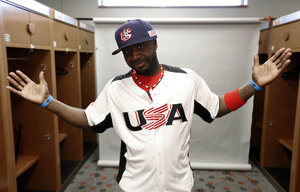World Baseball Classic: Everything you need to know
As the global tournament steps to the plate overnight March 2, here's a very quick viewer's guide.

Cincinnati Reds second baseman Brandon Phillips tries on a USA World Baseball Classic uniform during photo day at the team's facility in Goodyear, Ariz., Saturday, Feb. 16, 2013. The US team is among 16 that vie over the next three weeks in a competition that occurs simultaneously but separately from Major League Baseball spring training.
Paul Sancya/AP
Spring training baseball is just revving up in Florida and Arizona, and Opening Day is still weeks away, yet the closest thing the sport has to a true world series (notice the lowercase) begins Saturday in Fukuoka, Japan.
That’s when the Japanese team that won the first two World Baseball Classics in 2006 and 2009 opens defense of its title against Brazil in the 16-team tournament. Here’s a short-course viewer’s guide:
- The Classic was created after the International Olympic Committee decided in 2005 to dump baseball (and women’s softball) from the Games beginning in 2012.
- Part of the problem in keeping baseball in the Olympics is that it’s hard to pull the best players out of Major League Baseball midseason. The Classic in effect takes the place of the Baseball World Cup, which was played for about 70 years with amateur and minor-leaguers. Major League Baseball supports the Classic, which is sanctioned by the International Baseball Federation, and doesn’t conflict with the MLB regular season.
- While the timing is a good fit in some ways, the drawback is that many players are hardly in midseason, much less postseason, form. Some have played over the winter, but others are trying to regain their groove.
- The tournament begins with round-robin play in four locations: Phoenix; Taichung, Taiwan; San Juan, Puerto Rico; and Fukuoka. The second round, which uses a double-elimination format, will be held in Miami and Tokyo. The semifinals and finals are scheduled March 17-19 at AT&T Park in San Francisco .
- Play starts in four groupings: Pool A: Japan, China, Cuba, and, Brazil. Pool B: South Korea, Taiwan, Australia, and the Netherlands. Pool C: Venezuela, Puerto Rico, Dominican Republic, and Spain. Pool D: Mexico, United States, Italy, and Canada.
- Beginning this year, the Classic switches to an Olympic-like four-year cycle instead of being held every third year.
- TV coverage: All 39 games will be televised on the MLB Network.
- In a new wrinkle, a qualifying system allows up-and-coming teams to play their way into the tournament. Spain and Brazil advanced out of qualifying play last September.
- MLB is well represented on the rosters of a number of national teams, including the Dominican Republic, which is wall-to-wall major-leaguers.
- Japan, the two-time defending champion, enters the current Classic with no MLB players. Ichiro Suzuki, Yu Darvish, and pitcher Daisuke Matsuzaka, the tournament MVP in both 2006 and 2009, are all sitting this one out.
- Joe Torre, who guided the New York Yankees to four World Series championships, is manager of an American team that features such stars as Mark Teixeira, Ryan Braun, R.A. Dickey, Joe Mauer, and Jimmy Rollins.
- The Classic offers ample evidence of baseball’s talent diaspora. Barry Larkin, the only modern player inducted into the Baseball Hall of Fame in 2012, is managing Brazil. Well-traveled big-leaguer Johnny Damon suited up for Thailand, his mother’s homeland, in that country's unsuccessful attempt to qualify. Former major-league hurler Bruce Hurst is China’s pitching coach.
- The single-game final makes for great drama, but purists would argue that the format doesn’t gauge the strength of a team’s pitching rotation the way a best-of-seven World Series does.
